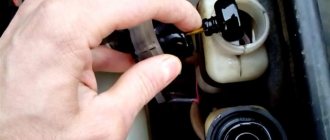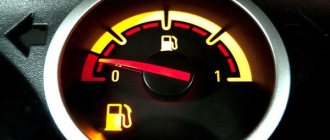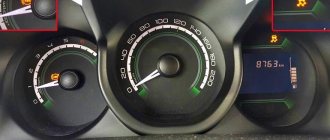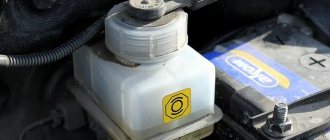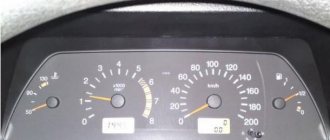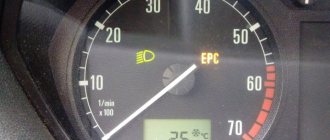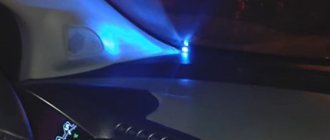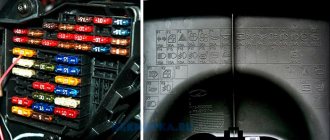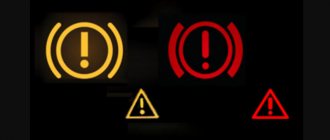It will be useful for many drivers of modern cars to know what to do if the ABS light comes on. Some drivers are even afraid to continue driving when this signal is triggered. In this case, there is no need to be afraid, the brakes will work, but the anti-lock system will not turn on.
This device was specially designed to make it easier to drive a car in extreme situations, which occur quite often. Those motorists who only drive cars with such a device are at a loss when driving cars without it.
What to do if the ABS light comes on
It will also be useful to know for those who are faced with choosing a car before purchasing. Everyone who has been using cars with such a device for a long time emphasizes the effectiveness of its use in winter. This helps make the vehicle braking safely when driving on slippery roads. To use this tool correctly, you need to study its features, structure and application.
What is ABS?
This abbreviation stands for anti-lock braking system. Its main task is to prevent the wheels from blocking when braking the car. It is based on sensors that are required to monitor the speed of the car, as well as the speed of rotation of the wheels. For most modern cars, an additional unit is installed, this is a brake force distribution system.
The figure shows that the ABS consists of the following components:
- Sensor that reads wheel rotation speed (installed on all wheels);
- Hydraulic block;
- Hydraulic unit performance monitoring unit;
- ABS unit warning light.
The main task of this device will be to regulate the speed of rotation of the wheels by changing the pressure in the brake system.
The main components of the ABS, namely the hydraulic unit and the control unit, are located in the engine compartment of the car. Their operation is only possible in conjunction with sensors located on the hubs of all wheels. Signals from the sensors are sent to the control unit, where they are processed and provide a control signal to the hydraulic unit, which distributes the braking force across the wheels. Performance indication.
The operating principle of the performance indicator is the same for all vehicles with ABS. The first signal from it appears immediately after turning on the ignition. The warning light indicates the operation of this device and should go out a few seconds after the engine is started.
If the light does not go out for some reason, it means that there are problems in this unit. If the signal of this lamp flashes while driving, then you need to check the functionality of the anti-lock braking system.
Reasons for turning on the warning light
The inclusion of a warning light on the instrument panel indicates to the driver that there is a problem with the anti-lock braking system. The brakes are in working order, but in extreme situations you will need to rely only on your driving experience. So why does the ABS light come on:
- One of the most common reasons for this situation is the failure of one or more sensors of this system. They are installed near each wheel on its caliper. A failure of any of them is sufficient to alert the driver to a malfunction. This can be caused by changes in the gap between the sensor housing and the rim of the gear rotor;
- The same can happen if the control unit loses communication with the sensors, caused by a break in the connecting cable or after oxidation of the contacts. Sometimes during maintenance or repair they are disconnected and then forgotten to be connected;
- A severe discharge of the battery can also trigger the light to turn on;
- Problems occurring in the hydraulic pump. They can be caused by a failure of the system's hydraulic valve or due to faults in the control unit itself. It can also result from inept intervention in the operation of the ABS.
How to solve such a problem?
Some may sigh and say that they have finally reached the goal of this article. If so, then I would like to offer some tips for solving such problems:
- Check that all device contacts are securely connected. There are only five of them in the system, one near each wheel and the fifth is located in the engine compartment of the car. The check is easy to do; you need to disconnect all contacts, clean off any dirt and oxidation. When all this is done, they are installed in their place;
- If the reason for the warning light to turn on is the ABS control unit, it is almost impossible to solve this problem on your own. In cars with an on-board computer, you can see the error code for this system. If you know how to decipher these errors, you can learn about the problem more specifically, but this does not mean that you can solve it yourself.
The benefits of installing ABS have probably already become clear to everyone reading this article. Attentive attention and maintenance will ensure its performance, and drivers will have confidence on the road. What to do if the ABS light comes on, we hope, has already become clear. If the tips you have read do not solve this problem, it is better to seek help from specialists.
How to find out what's wrong with the anti-lock braking system?
Before the advent of ABS in the auto industry in the 70s of the 20th century, cars were more dangerous. Especially when you were driving on snowy, icy or wet roads. In those years, as a rule, old cars were equipped with not very high-quality tires, rear-wheel drive and a conventional braking system without electronics. But today everything has changed. These days, most of us don't even think about modern braking systems. Today we feel confident even when driving or in very icy conditions. The fact is that most modern cars are equipped with front-wheel drive, which gives drivers confidence behind the wheel, modern electronic safety systems that control the car’s grip on the road surface and modern tires that demonstrate the wonders of road grip. One of the most important systems in any car is the anti-lock braking system (ABS), which significantly reduces braking distance and prevents wheel locking, which can lead to loss of traction and, consequently, skidding.
ABS has become standard equipment in the auto industry and is installed on virtually every vehicle manufactured by auto companies these days. As we have written more than once, the ABS system consists of speed sensors that are installed on the wheels of the car, an electronic control unit for the anti-lock braking system, and hydraulic valves, which, based on a signal from the electronic unit, regulate a certain braking force in each wheel without driver intervention.
ABS wheel sensors monitor the rotation speed of each wheel of the vehicle and continuously transmit it to the computer. As soon as the ABS unit begins to see that a wheel has stopped rotating, it activates the hydraulic brake system valves, which reduces the brake pressure in that wheel. As a result, the brake fluid pressure in the wheel drops and the braking force is reduced, which helps to unlock the wheel and regain traction. This process is repeated several times per second until the car stops or the driver releases the brake pedal.
The ABS control unit and the vehicle computer perform a self-test of the anti-lock braking system every time the ignition is turned on. That is, every time you start the car, an automatic test of the ABS system occurs. If during self-testing the computer receives insufficient data from the sensors, ABS control unit and hydraulic valves of the brake system, the ABS warning light comes on. For example, if the car's computer or ABS control unit does not receive a signal from the hydraulic pump of the brake system or from the valve installed on each wheel, then the ABS error in the form of an icon (indicator) will light up on the device.
Please note that despite the malfunction of the ABS system and the appearance of a lit ABS icon on the dashboard, the mechanical braking system in your car usually continues to work and you can, in principle, continue driving, but without an electronic wheel lock assistance system during braking. That is, in other words, if the ABS system breaks down, you can safely use the car. However, in this case, you must be extremely careful when braking on a slippery, snowy or wet road, since without an ABS system, your car’s wheels may lock. Therefore, we do not recommend operating the car for a long time without appropriate repairs if the ABS system malfunctions. So in case of an ABS system error, you must determine the cause of the problem as soon as possible and fix it as soon as possible.
Where is the speed sensor on the Lada Granta: photo and price
Car: Lada Granta. Engine: 21116. Asked by: Damir.
Yesterday I came home, started climbing onto the curb and slightly hit the bottom of the car. And then it started. The speedometer needle began to dance, at first it seemed to me that it was even accompanied by music. Then it twitched at zero, twitched to 200, and fell again. No errors occurred; the engine warning light did not light up on the instrument panel.
She didn't get up again. I drove around the yard, looked smartly under the hood, and screwed in all the chips I saw. Did not help.
Knowledgeable people said that the speed sensor was broken, quite logical, but where is it located? I went to a car store to buy a new one to check, the store is good, they accept returns if there was no loss of presentation. And the seller told me that when the speed sensor breaks down, the electric power steering also doesn’t work, but for me it works.
Speed sensor location
The following two tabs change content below. An expert on Lada cars with many years of experience. I own a Lada Granta car, I collect cramps based on the Priora. Sometimes I stay overnight in the garage. My wife is more jealous of cars than of women.
The speed sensor on the Lada Granta is located between the BDZ (throttle valve unit) and the brake fluid reservoir.
Replacing the speed sensor
- The sensor can be removed by removing the air filter and inlet pipe. Remove the pipe and move the air filter housing to the side
- The sensor is secured with a nut, which can be easily unscrewed with a regular 10 mm wrench.
- Unscrew the nut, disconnect the chip, and remove the speed sensor. Nut 10 and the chip is removed
After you have removed the sensor, clean it; debris may have gotten on it. Since its body consists of a magnet, it could become clogged when it hits a curb.
New and old speed sensor
However, this is unlikely; most likely it has failed and requires replacement. But if there was dirt on it, then there is a chance that it is working. Put it back, connect the chip and test drive it to check.
Electric power steering failure due to speed sensor failure
Indeed, if the speed sensor breaks down, the electric power steering in some cars fails, and error P-0501 (Vehicle speed sensor signal outside the permissible range) should appear on the instrument panel. That's why the steering wheel refuses, so that the car understands that the sensor is broken. In your case, the nature of the failure said that the sensor shows zero speed.
ABS system malfunction
So. Your car has a warning light or icon on the dashboard warning you that there is a problem with the anti-lock braking system. What to do in this case?
First, first make sure that the indicator light indicates a problem with the ABS system, and not a malfunction of the entire brake system.
To do this, you must listen carefully to your car while braking and pay attention to the brake pedal. If during braking you begin to hear extraneous noises (whistles, knocks, squeaks, etc.) or the brake pedal has become too soft (softer than usual), then your direct route is to a technical center, where specialists must conduct a thorough diagnosis of the entire brake system. systems. Remember that these signs indicate a serious problem with the entire braking system. This can lead to an accident while driving. Therefore, if your car's brakes have become very bad, we do not recommend driving on public roads as this is very dangerous. In this case, call a tow truck.
Also, in order to find out that the ABS light is the cause of the malfunction of the anti-lock braking system, you must also make sure that there is no air in the brake system, that the brake pedal is still hard and not too soft, and that there is no air in the brake system. To do this, first check the brake fluid level, and then all brake pipes and hoses for depressurization.
In addition, when you turn on the ignition and see the ABS icon on the dashboard, do not rush to panic. This may be a common error in the car's electronics. Therefore, try turning off the ignition and removing the key from the ignition, and then turning on the ignition again and checking whether the ABS icon appears on the dashboard again. Repeat this process several times. It is quite possible that this is a simple car computer error and after turning the ignition on and off several times, the ABS system error will disappear.
If, after several attempts to turn the ignition on/off, the ABS system error on the dashboard does not disappear, you have two options:
The first option is to go to a car service center where you need to conduct a thorough computer diagnostic of the car. The main feature of diagnosing the ABS system is the electronic interrogation of the ABS unit using special equipment for possible errors in the system.
Using such diagnostics, a specialist will be able to determine the error code in the ABS system, which led to the appearance of the ABS signal icon on the dashboard.
Also, this error code will give a hint where exactly to look for the cause of the ABS system malfunction.
The second option is only for those who want to get to the bottom of the truth on their own.
In order to test the ABS system without using expensive diagnostic equipment, you need a service manual for your car (a book on the repair and operation of your car model), a simple automotive tool that is sold at any car store and a high-resistance (high-impedance) multimeter. If you cannot find a repair book for your car model on sale, then look for it on the Internet and simply download it to your computer or smartphone.
Please note that in some cars you can access diagnostic fault codes stored in the computer without using a special diagnostic scanner. To do this, you can check each electronic unit of the car (including the ABS control unit) using the “old” proven method: using two wires that you must connect to the corresponding connectors of the electronic systems. For example, you can connect two wires to test for a closed circuit in the ABS control unit. To do this, connect two wires to the ABS control unit connector and close the wires with a pin or paper clip. If after this the ABS error disappears from the dashboard, then the cause is an error in the anti-lock braking system control unit. Also, certain pins can be connected using a paper clip or pin without using wires.
If your car is equipped with a modern computer, the diagnosis of errors is carried out only by connecting the scanner to the OBD II (On-Board Diagnostic) diagnostic port, then in order to establish the reason for the appearance of the ABS icon on the dashboard you will only need electronic diagnostics, which you can done either at a technical center or using a purchased inexpensive error scanner via the OBD II port.
Let's assume that you don't yet have any information about the errors in the car's computer that led to the ABS icon appearing on the dashboard. Don't rush to do computer diagnostics. First, check the ABS control unit fuse. After all, a common cause of malfunction of the ABS system is the fuse of the anti-lock braking system control unit.
And so you checked the ABS control unit fuse, and it turned out to be in working order. Now what? Now you should use a multimeter to check the voltage and resistance in all electronic parts of the ABS system. To do this, read the vehicle operation and repair manual for all the corresponding control values for voltage and resistance in the ABS sensors and in the ABS unit itself.
However, before this you should check the main wiring harness that is connected to the ABS control unit. Carefully inspect the wiring harness responsible for the operation of the ABS system for damage. Also remove the wiring harness connector from the ABS control unit. Inspect the contacts in the connector for contamination, oxidation, etc. All contacts must be clean. If the contacts need to be cleaned, use a special aerosol spray for cleaning electrical contacts and connectors to remove dirt from the connector.
Also, when inspecting the ABS wiring harness connector pins, look for corrosion on the pins. Remember that even microscopic oxidation and corrosion chemicals can seriously increase the resistance in the ABS system electrical circuit. Since a small voltage of electricity (millivolts) is transmitted through the wires, even the slightest increase in resistance due to contamination of the connector contacts can lead to improper operation of the entire electronic part of the ABS system. Including causing an error, which will lead to the ABS indicator lighting up on the dashboard.
If the ABS controller appears intact and is in working order, and disconnecting the ABS harness connector from the anti-lock brake system unit did not help you solve the problem of the illuminated ABS icon on the dashboard, then it is time to check the health of the wheel speed sensors that transmit information ABS control unit. First, measure the resistance of the sensors, checking them with the reference values specified in the repair manual for your car.
If the resistance is within acceptable limits, then proceed to visually inspect the wheel speed sensors, the wires suitable for them, and inspect the condition on each gear axis (or on each wheel hub) that are installed on each wheel. As a rule, such sensors, related to mechanical sensors, were installed on old cars.
Also, many modern cars currently use sensors that require electrical power. Typically, ABS sensors are used based on the Hall effect (a semiconductor wafer is installed inside the sensor), which interacts with a magnetic ring on the wheel hub to record the change in the magnetic field, as well as the rate of electron formation on the wafer in the ABS sensors.
Unfortunately, not in all cars, ABS sensors and the wires through which the signal from the sensors is sent to the ABS system control unit are reliably protected from an aggressive external environment. As a result, ABS can fail due to damage and dirt.
In order to check the condition of the wheel speed sensors and ABS wires, you must first remove the wheels. For example, one by one, lifting the car with a jack from the desired side.
This will give you access to the sensors and wires.
If, when inspecting the ABS wiring harness and wheel speed sensors, you find damage (or the wheel speed sensor is not securely fastened or is loose), then consider that you have found the cause of the error on the dashboard telling you that the ABS system is faulty.
If, when inspecting the wires and ABS sensors, you do not find any external damage, then remove the ABS speed sensors from the hub (or axle) and check their resistance using a multimeter (if you have not done this before). Control values for resistance in wheel speed sensors can be found in special books on repair and operation of your car model.
We also advise all car owners to periodically inspect the wires of the wheel rotation sensors of the ABS system, even if the anti-lock braking system is working properly and the ABS icon does not light up on the dashboard. The fact is that since the wires and wheel rotation sensors are located at the bottom of the car, they are constantly exposed to the aggressive influence of the external environment. The main enemy of wires and sensors is the salt contained in the road reagent, water and snow.
The main causes of ABS system malfunction
If the ABS light comes on on the dashboard, this indicates problems in the system. The driver needs to contact technical service to find out the reason for this warning signal. When the system is working normally, the light starts to light when the engine is started, and after a few seconds it goes out. This indicates that the system is working properly and is in an active state. There are times when the light is on, but the car does not start.
In this case, there are many reasons, such as:
The problem lies with the connecting cables;
The ABS system control unit is faulty;
There is no connection with one of the sensors that is mounted on the wheels;
The sensor on one of the wheels or the sensors on all wheels have failed. As for a wire break, it can happen while the car is moving. During vibrations when driving on bad roads, cable connections begin to weaken and at some point break or even break off. The driver will be able to solve a problem of this nature on his own, without turning to professional specialists for help.
If the ABS light comes on due to sensor failure, then this may be due to debris that gets clogged while driving. The driver cannot solve this problem on his own. You need to take your car to a service station. Often the reason the sensors do not work is due to the incompetence of the mechanic at the service station. During wheel repairs, the sensors are constantly turned off. Only after the craftsmen have installed them back do they forget to connect them to the wheels. Improper wheel alignment will also cause the ABS light to come on.
You need to be extremely careful with the ABS system, because it can be broken quickly, and repairing them will require a lot of effort, time and money. If the ABS system light comes on due to a broken control unit, then you cannot find out on your own. Only the on-board computer, which displays an error code, can save the ABS system. This code must be deciphered correctly, because it is the cause of the system failure.
If the ABS light periodically turns on and off, you should know that there is a problem with the contacts. The connection between the contacts is weak and therefore the wires need to be inspected. It is much more difficult to independently identify the reason for the constant light of the indicator.
Sometimes the functioning of the ABS system goes wrong and in this case there is no need to contact technical service for help. There is a simple way to do this. You need to accelerate on a flat section of the road at increased speed, and then brake sharply. Sometimes this procedure helps restore a broken system.
If this does not help, then only experts can come to the rescue, who will diagnose the system on a special computer and draw an accurate conclusion as to why the ABS light came on. You cannot spare money on such a service, since the life safety of not only the driver, but also the passengers who may be in the car depends on it.
A modern car is equipped with various vehicle status indicators. Most systems are controlled electronically, but the feedback by which the computer communicates with the driver is the blinking of lights or some kind of light elements.
Young drivers may be alarmed by the situation in which the ABS light is on. In this case, there is no reason for critical panic, because the main braking system should remain normal.
The anti-lock braking system helps to minimize driver and road inconvenience when pressing the brake pedal. The wheels do not lock, causing the vehicle to spin or lose control. The car brakes and continues to move in a straight line.
ABS helps with braking impulses by rotating/locking the wheels in a specific sequence. When the system operates, skidding is practically eliminated, and the vehicle speed gradually decreases.
The ABS system includes the following elements:
- hydraulic block;
- electronic sensors located on each wheel;
- an element that monitors the correct operation of the hydraulic unit;
- indicator light on the dashboard.
The dashboard does not light up when the ignition is turned on
Hi everybody. This problem happened out of the blue. Yesterday at 22-00 I parked it after 300 km of run, and in the morning I came - and such a problem. Klaxon, interior lighting, door lights, the clock is working, the hazard lights on the dash (lights and relays click) - this means the battery is alive (12.5 V in the voltmeter in the cigarette lighter).
The first few times you turn the key, the relay above the glove compartment under the dashboard clicks, and the heater fans spin as usual. But after 5 times it all starts to be silent. Only the starter turns, but to no avail. Also “silent” are, in addition to the lights on the dashboard: the LPG button and the fuel pump. And one more thing: when I sit in the car and turn on the alarm from the remote control, and then remove it from the alarm, the LED on the antenna previously stopped blinking when two things happened: the water opened. doors and turning the ignition key. Now only from the waters. doors. Everything comes together at the ignition switch, but that’s it...
P.S. I checked the 1st relay under the hood (pulled it out and put it in)
I ask for help and advice. I unscrewed and screwed in the battery light on the dashboard. I watched the previous ones. Where to dig? The lock? So it was changed 2 years ago, though to a Chinese (Turkish) one.
Update: the problem turned out to be in the chip (block) of the ignition switch.
Identifying problems
If the ABS light comes on while driving, this is a signal that the entire system or its individual elements are not working correctly. A normal sign of performance is that it lights up when the car starts, and after a few seconds it should go out.
At this time, the ABS performance is tested. Signals are sent to all sensors, and response impulses are received from them.
When the ABS icon comes on and does not go out even while driving, this may be a consequence of the following problems:
- problem with communication
with any sensor on one of the wheels; - breakdown
in the control unit; - poor contact
in connecting cables; - failure
in all sensors.
Wire breaks occur while driving, as well as during intense vibrations on a bad road. The connections in the connectors become loose and breakage occurs. These faults can be resolved independently without contacting the specialists of the car company.
Also, the reason why the ABS sensor is on may be that debris or dirt has gotten onto the working surfaces of the sensor located on the wheel. It is enough to wash the car thoroughly and the indicator will go out.
You need to remember how long ago you visited a car service center, because inexperienced technicians diagnose wheels by removing the wires from the sensors. After this, would-be specialists forget to return everything to its original position, and the light on the panel continues to burn.
Malfunctions with the control unit will be more problematic. You can identify them using the on-board computer, which will display a system error code. Using this data, the problem with anti-blocking is calculated. It is unlikely that you will be able to resolve the issue yourself, so a trip to a car service center will be required.
Instrument cluster display does not show data periodically
Good afternoon Problem with the display on the Lada Granta instrument panel. Sometimes it stops displaying information about vehicle performance. The display itself is fine. It helps if you disconnect the battery terminal, or simply stop the power supply to the instrument panel (by removing fuse F34). The most interesting thing is that if you do nothing, then in a day or two, the display can start working on its own and start showing everything. Share your thoughts on where to start looking for a solution to the problem. Since this behavior in his work is a little confusing. Thank you in advance))
Solving the problem yourself
For those who are used to acting decisively, we can advise you to open the hood and find the electronic control unit. After disconnecting the battery, inspect the case for damage or water getting inside. If necessary, you can dry everything from excess moisture.
We check all connections in the fuse box. It is necessary to know that several fuses can be used simultaneously for ABS operation.
It is worth checking the wires going to the wheel from the ECU. They may become separated or fray during use. Such diagnostics are carried out with the car jacked up.
In some cases, it is enough to accelerate on a flat, empty road and brake sharply. In this case, all systems must work correctly, and the indicator must go out if there is a temporary failure in the ECU.
In cases where the ABS is working normally, but the lamp is still on, it is enough to remove the battery terminal for a few minutes to reset the system. Everything must return to normal.
When none of the suggested cases of putting the display in order helped, you need to boldly go to a car service center in order to identify and eliminate the error using computer accurate diagnostics.
Some car enthusiasts are afraid that when the ABS light is on, it somehow affects the operation of the braking system as a whole. They urgently begin to scour the entire Internet in search of an answer to why the ABS light is on and what to do. But don’t panic so much, the brakes on your car should be in perfect order, only the anti-lock system will not work
, which, in principle, is not critical, although in some emergency situations it helps a lot. To understand the system, I recommend reading about .
Tidy reset
To perform the procedure, you should scroll the shield regulator until the dial is reset to zero. If you need to perform a full reset of the panel, you need to disconnect power from the battery for 15 minutes and reconnect the wires.
The Grants panel is quite advanced and easy to understand for the driver. The indicators are intuitive, making it easier for novice drivers to learn.
Specialization : Graduated from the State Automobile University, worked for 20 years at GAZ-56, now I drive a Zhiguli.
Source
What to do if the ABS light is on?
It is worth noting that the system works normally if the ABS icon lights up when the ignition is turned on and goes out after a couple of seconds. The first thing to do if the ABS light is constantly on
- this is to check the fuse for this system, and also inspect the wheel sensors.
Quite often, the sensor connector on the hub either oxidizes or the wires fray. And if the ABS icon is on after replacing the pads or hub, then the first logical thought is that you forgot to connect the sensor connector
. The presence of dirt on the sensor also causes the indicator to light up.
Quite often, car owners may be frightened by the appearance of an orange ABS icon after a good slip. In this case, you shouldn’t bother at all: brake sharply a couple of times and everything will go away on its own - the control unit’s normal reaction to such a situation. When does the ABS light not stay on?
, but periodically, then you need to inspect all the contacts, and most likely, the reason for the warning indicator to light up can be quickly found and eliminated.
Power fuses
The power fuse box is located under the hood and is located between the battery, strut support and coolant reservoir. Looks like a vertically mounted box. By removing the top cover, access to the power fuses appears.
F1 (50 A) - electric power steering . If the steering wheel turns hard, also check fuse F32.
F2 (30 A) - heater fan
F3 (60 A) - generator . If the battery discharges quickly or the discharge lamp is on, check this fuse, as well as the operation of the generator itself and its brush.
F4 (60 A) - generator
F5 (30 A) - low beam headlights . Also check relay K9 and fuses F12, F13.
When troubleshooting any electrical problems, use caution. Replace fuses and relays only with the engine off and the ignition off.
If your fleet contains not only Grants, you can also read about Kalina fuses and relays.
Causes of ABS error
The main possible reasons for the constant display on the dashboard:
- the contact in the connection connector has disappeared;
- loss of communication with one of the sensors (possibly a wire break);
- The ABS sensor has failed (the sensor needs to be checked and then replaced);
- the crown on the hub is damaged;
- The ABS control units have failed.
After inspection and, it would seem, elimination of the cause, it is very easy, you just need to accelerate to 40 km and brake sharply - the vibration of the pedal will make itself felt and the icon will go out.
If a simple inspection for damage in the sensor circuit to the unit does not reveal anything, then diagnostics will be needed to determine the specific error code
anti-lock brake systems. On cars where an on-board computer is installed, this task is simplified; you just need to clearly understand the decoding of the code and where the problem could arise.
Checking the fuel oil level sensor
Checking it is quite simple; to do this, you need to unscrew the brake reservoir cap without disconnecting it from the connector. Then forcefully raise the “float”, then the lamp should go out; if this does not happen, then most likely the problem is in the sensor.
The next step is to check the control circuit. To do this, disconnect the sensor from the connector and insert a jumper into the plug, closing the two contacts together. When closed, the lamp should light up.
We hope our article was useful to you.
